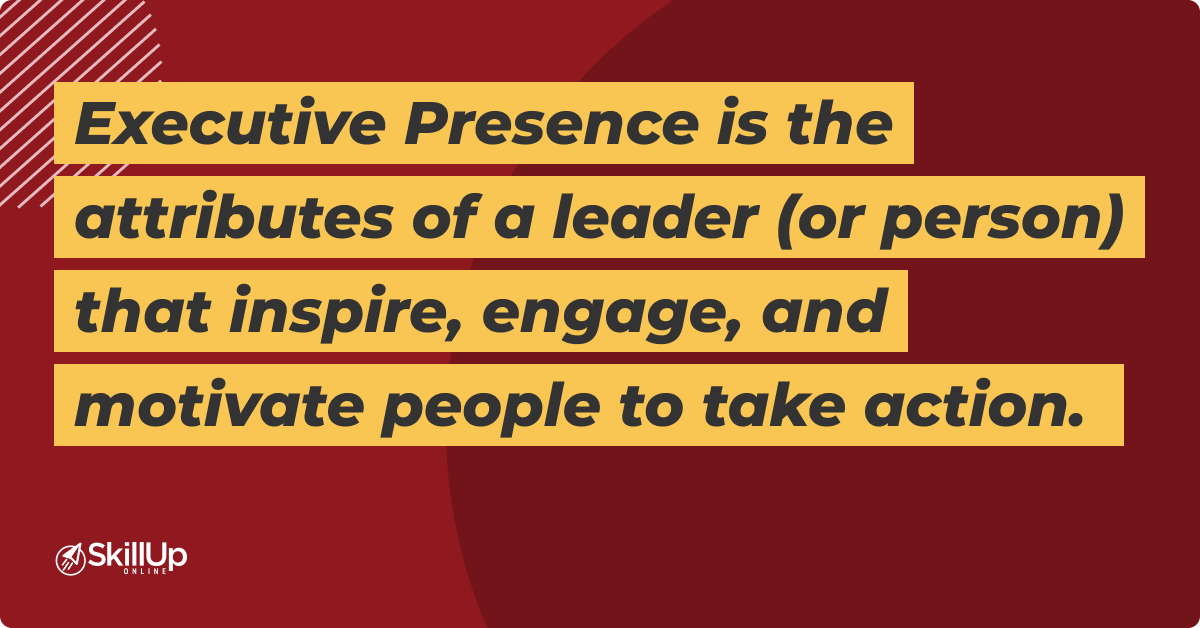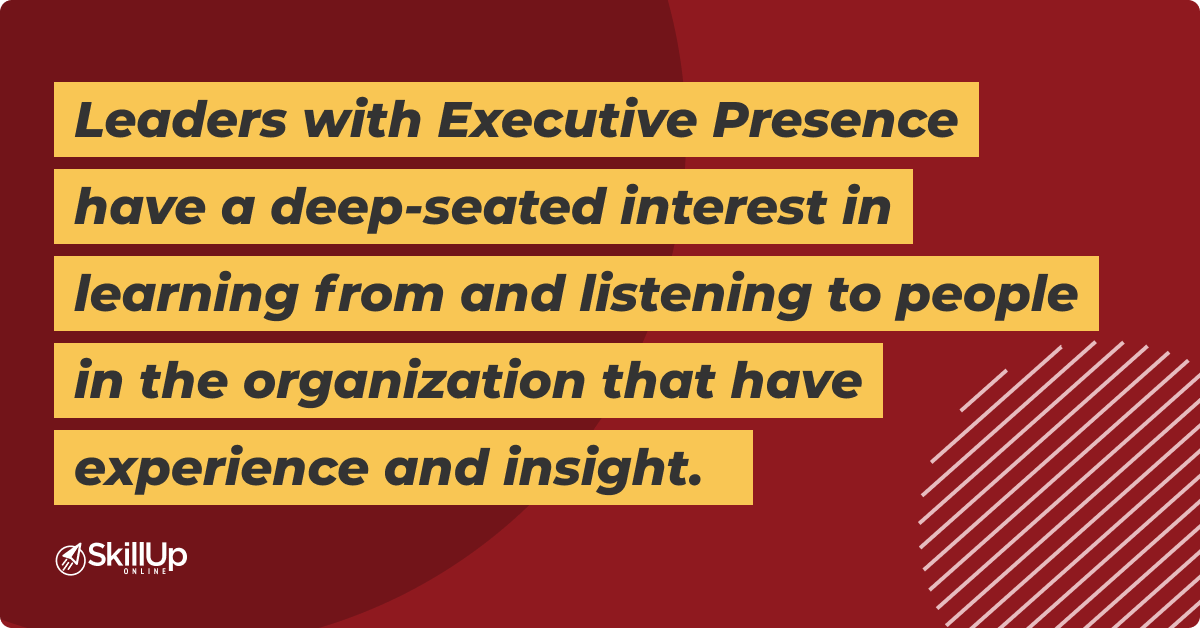Brian was disappointed. He had just been turned down for a senior leadership role at his current company, and he wasn’t quite sure why.
Playing through his mind repeatedly was the direct feedback he had been given. “You are lacking Executive Presence,” his boss had said. It didn’t make much a sense.
So, keen to understand his deficiencies and find a solution, he pushed his boss for a bit more information. Unfortunately, the response he received was ambiguous at best. His boss stated, “Executive Presence is a required quality of all senior leaders in our company. It’s difficult to frame with a definition, but I know it when I see it, and unfortunately you are lacking.”
What could Brian do to sort his ‘lack of Executive Presence’ out?
Professional Guidance & Training
In my many years of consulting on the topic of Executive Presence, Brian’s story is very typical. And his challenge is understandable.
First off, without full awareness of what Executive Presence is, it’s hard to self-assess. However, if you ask ten different business leaders for their definition of Executive Presence, you will likely get ten different answers. And this makes it even harder to resolve.
So why is this the case? Well, as a topic, Executive Presence casts a long shadow across many different attributes; appearance, work ethic, vision, perseverance, persuasiveness, authenticity, relatability, and sense of humor are just a few of the attributes that are directly correlated to one’s Executive Presence.
So where do you start?
What is Executive Presence?
To begin the process of improving your Executive Presence, it’s critical to understand the definition of it. Fortunately, that definition is relatively simple.
Executive Presence is the attributes of a leader (or person) that inspire, engage, and motivate people to take action.
Let that sink in for a minute. Truly, Executive Presence is defined and understood through its correlation to many different attributes. So, if you want to begin the process of understanding your Executive Presence, you need to begin exploring your aptitude across these various attributes.
Fortunately, these attributes are much easier to understand, define, and improve upon because they can be tackled in bite-size chunks.
Exploring the Attributes of Executive Presence
When I conduct a workshop or provide consulting services on the subject of Executive Presence, I dedicate a significant amount of time exploring all the associated attributes.
At current count, there are 30 of them that I examine, and I invite the learner to self-assess their proficiency against each one.
For the rest of this article, I will focus on a few of the attributes that can have the biggest impact on your Executive Presence. And, as you read my comments, I invite you to consider your proficiency in these areas and identify opportunities for growth.
Passion
I spent 22 years of my career at Microsoft, with the last 11 years in a role where I led a team of managers who administered premier support contracts for Fortune 500 companies.
Much of that role was focused on helping my team help our customers consume their support contracts and be ready/willing to renew their contracts in 12-month intervals. Return on investment, contract consumption, customer satisfaction, and contract renewal were the ongoing marching orders.
But somewhere during those last 11 years, my passion started migrating further and further away from these orders. Instead, I found myself getting more and more interested in career coaching, leadership development, and motivational speaking. I remember with absolute clarity the day my boss sat down with me and asked, point blank, “Do you like your job and is this something you want to be doing?”
The reality was that my passion for my job, as it was defined, had all but evaporated.
I was doing my job, and I was meeting my responsibilities, but my heart wasn’t in it. My drive and determination and passion were almost extinct, and it showed.
If you are not passionate about what you are doing, it will show. However, those with Executive Presence exude passion. It is a passion that inspires people and makes them want to get on board and follow the path that you are walking. And so, to have Executive Presence you need to fuel your passion.
Listening
I had just spent the past 12 months developing and deploying a training program for top performers in the organization who had aspirations of becoming people managers.
The training was a huge success, with overwhelmingly positive feedback. The success was so pronounced, in fact, that I was invited to meet with the Senior Vice President to provide an overview of the program and see if it should be launched across all departmental organizations.
I spent hours and hours preparing for this meeting and rehearsed my commentary repeatedly. I had created a compelling PowerPoint presentation and was anxiously looking forward to the opportunity to meet with the Sr. VP.
The day arrived and upon entering their office, I was informed that time was tight, so I should jump right in with my presentation.
About 30 seconds in, while I was still on the first slide, they interrupted me and asked, “So you are proposing to take all of our top performers through this training to help prepare them for an opportunity to be people managers?”
I replied, “Yes.” But as I moved to explain the additional benefits of this training, I was interrupted again.
“But people manager openings are so infrequent, we would just be setting up all our top performers for disappointment because they wouldn’t be given enough opportunities to move into the roles they are targeting.”
And with that statement, the meeting was adjourned, I was thanked for my time, and I was invited to leave.
Leaders with Executive Presence have a deep-seated interest in learning from and listening to people in the organization that have experience and insight.
They are laser focused on gathering and collecting feedback from others and treat that feedback with value and respect. And even when presented with information that doesn’t seem to align to their thinking, they still show a desire to listen intently.
Unfortunately, my estimation of this Senior Vice President’s Executive Presence took a major negative hit through their disinterest in listening to the presentation I had so carefully prepared.
Transparency / Candor
Early in my management career I was leading a team of 10 Senior Technical Support Specialists who provided mentorship to about 100 front line customer support agents at a third-party vendor.
We had hired this vendor about three years prior and had spent a lot of time getting them to the point where they were hitting customer satisfaction and call-time targets. However, this was also the time when customer support operations were being moved overseas to lower cost labor markets.
As such, I was given the task of shutting down this call center with an operational end date that was six months in the future. I was also tasked with making sure the performance of this third-party vendor did not deteriorate during the ramp-down timeframe. And finally, I was informed that at the end of the six-month window, the 10 Senior Technical Support Specialists reporting to me would need to find a new job, or they would be laid off. And so, I had a decision to make.
I could keep all these developments a complete secret, maintain the status quo, and hope that the performance of our third-party vendor did not decline. Or I could inform the Senior Technical Support Specialists about the plan, give them an increased runway to plan for their pending career change, and hope that in so doing they would not communicate this to our vendor.
Indeed, I knew that if our vendor became aware of the loss of the business, they would immediately begin making changes that would hurt business performance.
I really struggled with how to handle the situation, but ultimately decided to be transparent with my direct reports, while at the same time getting their commitment to not share any of this news with our vendor.
I remember distinctly calling them into a conference room for a special meeting and swearing them all to secrecy, which was an agreement they all made.
Then next morning, at 8:30 AM, I received a phone call from Russ, the site manager at our vendor. His question to me was direct. He said, “Ben, I’ve just spent the last 30 minutes with three of our top performing customer support agents in my office, and each of them is telling me that they’ve heard from your team that our site is going to be shut down in six months.”
This entire experience had a profound impact on me and how I viewed the management role.
There was a period of time where I was very angry with myself for being so transparent about business operations. And I was angry with some of my direct reports for not waiting even 24 hours before breaking the promise they made.
And sadly, after confirming to Russ that what he had heard was true, vendor performance did decline as word got out and their top support agents began moving to other projects. Plus, ultimately, my opinions and overall experience changed.
To be clear, there are times when it is critical to keep business realities from spreading too soon. In this example there were tangible negative consequences I suffered from being so candid with my direct reports.
However, in hindsight, one of the most powerful positive results of my transparency emerged over time as I continued to work with these 10 direct reports in various capacities over many years to come. Their regard and respect for me became profound as they experienced first-hand my willingness to trust them and be transparent. The way they viewed me as a leader and regarded my Executive Presence was exponential.
If you’re looking to increase your Executive Presence, you need to understand the strong connection that exists with the attributes I’ve outlined above. It’s your managers, peers, and direct reports that ultimately determine your level of Executive Presence, and they do so by observing your performance against these attributes.
If you’d like to find out more about how to build your Executive Presence, contact our Learner Support Team at [email protected]. They will be more than happy to guide you on your next steps.
SkillUp Online









